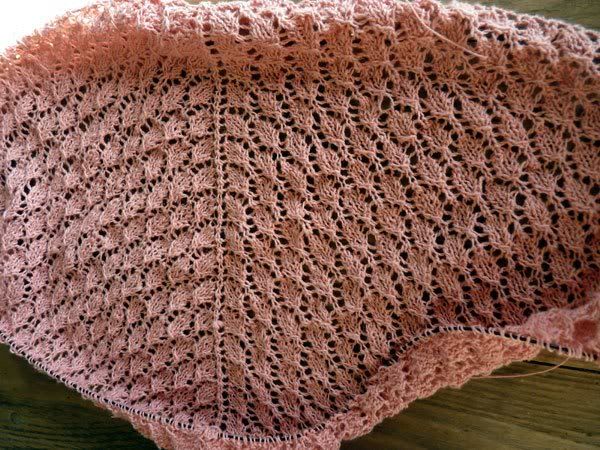 There are some patterns out there that are the knitting equivalent of the pop-culture fad - like sorority girls love ugg boots, or scene kids are drawn to neon, there are some patterns that have been made by pretty much everyone interested in that kind of knitting. For lace knitters, that pattern is the Swallowtail Shawl. A complete stranger, upon seeing my Melusine shawl at RenFaire, stopped me to tell me about the Swallowtail she had just completed. She broached the subject confident that I would know exactly what pattern she meant, and I did. At last count there were 6229 completed Swallowtails listed on Ravelry.
There are some patterns out there that are the knitting equivalent of the pop-culture fad - like sorority girls love ugg boots, or scene kids are drawn to neon, there are some patterns that have been made by pretty much everyone interested in that kind of knitting. For lace knitters, that pattern is the Swallowtail Shawl. A complete stranger, upon seeing my Melusine shawl at RenFaire, stopped me to tell me about the Swallowtail she had just completed. She broached the subject confident that I would know exactly what pattern she meant, and I did. At last count there were 6229 completed Swallowtails listed on Ravelry.It's popular not only because it results in a beautiful lace shawl, but because the pattern is so clearly written out. Fairly often, lace patterns resemble nothing so much as the ramblings of a Japanese lunatic that have been translated into Russian by a French speaker, and then translated into English by a native speaker of Urdu. Some very important details get lost in the translation, and unless you're either extraordinarily brave or a mind-reader, these patterns are not always much fun to attempt. The Swallowtail pattern is not like that. If you follow it line by line, it is as easy as a basic dishcloth pattern. And this is something that everyone comments on. "Oh, start with the Swallowtail for your first lace project. It's so easy!" "You can't go wrong with the Swallowtail, it's so simple!"
Ha, I say, laughing the laugh of the bitter and potentially stupid.
If you do follow it exactly, I'm sure it really is easy. But, supposing, instead of using size 4s and lace-weight yarn, you end up using size 1.25s and some thread-weight cotton of unknown origin, which gives you a gauge of roughly 700 stitches to the inch (okay, so, maybe 25 stitches to the inch, but still...). Then, dearies, the Swallowtail is not easy. It is not simple. It is MATH. And MATH is something we all know that I, as a good History major, loathe.
To illustrate my point: If you should decide to knit more repeats of the body pattern than the 14 that are called for, that's all well and good. Other people have done it, and it turns out fine. But if, and only if, you repeat in multiples of 5. If you knit 19 repeats, or 24, then you're good, and the Lily of the Valley pattern comes out perfectly with no finagling. If, however, you are too stupid to check your math and just pick a random number of repeats and go with it, you will find that nothing will work out right for the next 21 rows.
Supposing, of course, that you manage to catch the first little problem and spend twenty minutes doing the math to determine that the number of stitches you need before you start the Lily of the Valley chart is a little formula that looks like the total number of stitches - 5 border stitches - 34 set up stitches + 4 stitches from the set-up row = a multiple of 10, you are not home free just yet. There is still the problematic matter of the Lace Border chart, which is not worked across a multiple of 10 stitches, but a multiple of 8. So having spent another twenty minutes doing some math, you should realize that you must now have another formula that looks like the total number of stitches - 5 border stitches - 14 set up stitches + 4 set-up row stitches = a multiple of 8. This was a problem for me, as I had increased exactly 100 stitches, resulting in a number that was not a multiple of 8, and could not be a multiple of 8 no matter how hard I willed it to be.
So, in the tradition of all those who have gotten this far into a lace pattern and decided, "screw it, I refuse to rip the bloody thing back again after all this work," I fudged it a little, and did a second "set-up" row in which I increased the necessary stitches evenly across. And now, hopefully, fingers crossed, I can finish the damn thing without having to do any more MATH. Of course, I'm not holding my breath.
I still haven't figured out if the pattern is just not as easy as is claimed, or if I am really just not as smart as most knitters.

Post a Comment